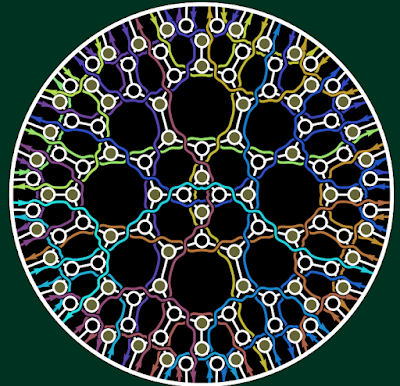Permutations join twistor minirevolutionThat report echoed a talk at Strings 2012. Finally, the paper is out.

One of the 263 figures in the paper.
On the 154 pages of their new article,
Scattering Amplitudes and the Positive Grassmannian (PDF),Nima Arkani-Hamed, Jacob L. Bourjaily, Freddy Cachazo, Alexander B. Goncharov, Alexander Postnikov, and Jaroslav Trnka expose the power of their new formalism based on the positive Grassmannians (a Grassmannian in this sense is a space of \(k\)-dimensional hyperplans in an \(n\)-dimensional hyperspace; the positivity condition means that all minors i.e. sign-corrected subdeterminants or minors have the positive sign).
The physical building blocks are UV and IR divergences and they are composed into magnificent structures by new Grassmannian-valued variables whose treatment may be described in terms of polytopes, permutations, and otherwise. Conformal theories are mostly analyzed in twistor variables because it is "wise" to do so. However, I feel that twistors have been downgraded to secondary technical tools in this research.
Their methods apply to 2-dimensional integrable systems, the 3-dimensional ABJM theory of the membrane minirevolution, the 4-dimensional maximally supersymmetric gauge theory, and others. They make the full Yangian (or related) symmetries manifest while obscuring locality. So far, I don't quite understand whether the appearance of these very different theories in one papers is just a symptom of some superficial mathematical similarity in the tools that can be used – this is what mathematicians often market as unification but I would never buy it – or whether the unifying picture is more profound.
It's a long paper and the length itself will probably discourage many people from reading it, especially people who resemble your humble correspondent by the expectation that a deeper understanding of a system should ultimately make it possible to write more concise explanations of theories, but a quick reading makes it self-evident that it's a paper that badly deserves to be read. So please try to look at it.
Update: I decided to read the paper rather systematically. It's beautifully written, many things that were only vaguely clear to me or that I had to "guess" are clearly articulated. I will probably postpone the evaluation of my potential far-reaching corollaries and interpretations (that I've spent quite some time thinking about) to a future date, after I am confident that I understand the known stuff properly.
0 comments:
Post a Comment